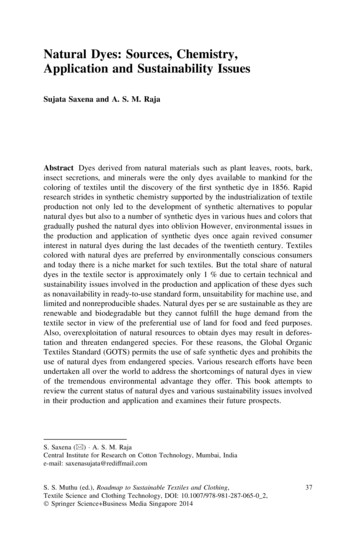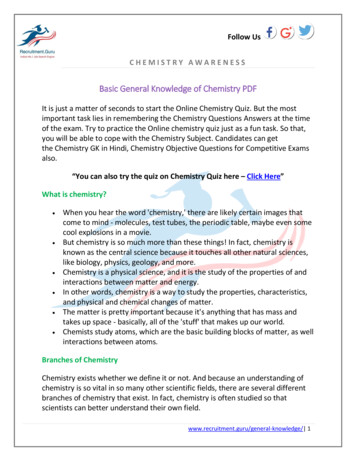
Transcription
Natural Dyes: Sources, Chemistry,Application and Sustainability IssuesSujata Saxena and A. S. M. RajaAbstract Dyes derived from natural materials such as plant leaves, roots, bark,insect secretions, and minerals were the only dyes available to mankind for thecoloring of textiles until the discovery of the first synthetic dye in 1856. Rapidresearch strides in synthetic chemistry supported by the industrialization of textileproduction not only led to the development of synthetic alternatives to popularnatural dyes but also to a number of synthetic dyes in various hues and colors thatgradually pushed the natural dyes into oblivion However, environmental issues inthe production and application of synthetic dyes once again revived consumerinterest in natural dyes during the last decades of the twentieth century. Textilescolored with natural dyes are preferred by environmentally conscious consumersand today there is a niche market for such textiles. But the total share of naturaldyes in the textile sector is approximately only 1 % due to certain technical andsustainability issues involved in the production and application of these dyes suchas nonavailability in ready-to-use standard form, unsuitability for machine use, andlimited and nonreproducible shades. Natural dyes per se are sustainable as they arerenewable and biodegradable but they cannot fulfill the huge demand from thetextile sector in view of the preferential use of land for food and feed purposes.Also, overexploitation of natural resources to obtain dyes may result in deforestation and threaten endangered species. For these reasons, the Global OrganicTextiles Standard (GOTS) permits the use of safe synthetic dyes and prohibits theuse of natural dyes from endangered species. Various research efforts have beenundertaken all over the world to address the shortcomings of natural dyes in viewof the tremendous environmental advantage they offer. This book attempts toreview the current status of natural dyes and various sustainability issues involvedin their production and application and examines their future prospects.S. Saxena (&) A. S. M. RajaCentral Institute for Research on Cotton Technology, Mumbai, Indiae-mail: saxenasujata@rediffmail.comS. S. Muthu (ed.), Roadmap to Sustainable Textiles and Clothing,Textile Science and Clothing Technology, DOI: 10.1007/978-981-287-065-0 2, Springer Science Business Media Singapore 201437
38S. Saxena and A. S. M. Raja1 IntroductionThe art of dyeing is as old as our civilization. Dyed textile remnants found duringarchaeological excavations at different places all over the world provide evidenceto the practice of dyeing in ancient civilizations. Natural dyes were used only forcoloring of textiles from ancient times till the nineteenth century. As the namesuggests, natural dyes are derived from natural resources. Coloring materialsobtained from natural resources of plant, animal, mineral, and microbial originswere used for coloration of various textile materials. Different regions of the worldhad their own natural dyeing traditions utilizing the natural resources available inthat region. Use of natural dyes started to decline after the invention of syntheticdyes in the second half of the nineteenth century. Concerted research efforts in thefield of synthetic dyes and rapid industrialization of textile production resulted inalmost complete replacement of natural dyes by synthetic dyes on account of theireasy availability in ready-to-apply form, simple application process, consistency ofshades, and better fastness properties. The tradition of using natural dyes couldsurvive only in certain isolated pockets. Recent environmental awareness hasagain revived interest in natural dyes mainly among environmentally consciouspeople. Natural dyes are considered eco-friendly as these are renewable and biodegradable; are skin friendly and may also provide health benefits to the wearer.Natural dyes can be used for dyeing almost all types of natural fibers. Recentresearch shows that they can also be used to dye some synthetic fibers. Apart fromtheir application in textiles, natural dyes are also used in the coloration of food,medicines, handicraft items and toys, and in leather processing, and many of thedye-yielding plants are used as medicines in various traditional medicinal systems.There are several challenges and limitations associated with the use of naturaldyes. The current dyestuff requirement from the industry is about 3 million tonnes.Considering this fact, the use of natural dyes in mainstream textile processing is abig challenge. As agricultural land is primarily required to feed an ever-increasingworld population and support livestock. and biodiversity should not be compromised for the extraction of dyes, sustainability of natural dyes is a major issue.This chapter discusses various issues related to the use of natural dyes in textilessuch as potential sources, chemistry, extraction methods, application methods, andsustainability issues.2 Potential Sources of Natural DyesNatural dyes are derived from natural resources and based upon their source oforigin, these are broadly classified as plant, animal, mineral, and microbial dyesalthough plants are the major sources of natural dyes. As interest in natural dyesgrew, information from the old literature was collected and traditional dyeingpractices in different regions were documented and compiled by various
Natural Dyes: Sources, Chemistry, Application and Sustainability Issues39researchers. Adrosko [1] published a book on natural dye sources and processes fortheir application to textiles at the household level. DOBAG, the Turkish acronymfor Natural Dye Research and Development Project, launched in Turkey withGerman assistance in cooperation with Marmara University, Istanbul in 1981 wasa big success in reviving the lost art of producing naturally dyed carpets. Naturaldyeing processes of India were documented in a book by Mohanty et al. [32].Chandramouli [9] also published a book on natural dyeing processes of India. Dyestraditionally used in the Scottish Highlands were reviewed by Grierson et al. [15].Buchanan [8] presented a detailed account of dye plants used for natural dyeing oftextiles such as alkanet, annatto, chamomile, coreopsis, madder, safflower, indigo,and so on, and methods for dyeing of textiles with these. Later information onvarious dye-yielding plants, methods to grow them, harvesting dye parts, methodsto dye wool and silk with them, and color shades obtained were also detailed byher [7]. Research efforts by individuals and organizations and exchange ofavailable information through various seminars, symposiums, workshops, andresearch articles have now revealed various natural dye sources. Plenty of information about different sources of natural dyes is now available in the literature [54,55]. A brief account of the potential dye resources according to their source oforigin is listed below.2.1 Plant OriginHistorically, plants have been used for the extraction of a majority of natural dyes.Various plant parts including roots, leaves, twigs, stems, heartwood, bark, woodshavings, flowers, fruits, rinds, hulls, husks, and the like serve as natural dyesources. The famous natural blue dye, indigo is obtained from the leaves of theplant indigofera tinctoria. Some plant-derived dyes have other applications also,for example, as food ingredients and medicines in traditional medicine systemsand hence a commercial supply chain of these dyes is in place. Some of the naturaldyes were well known in the past for their dyeing properties and have remained inuse even now, albeit on a small scale. A renewed interest in natural dyes hasincreased their commercial availability. Some such important dyes reported inmany publications [6, 19, 26] are listed below.2.2 Blue DyesIndigo is the only important natural blue dye. Leaves of the plant indigoferatinctoria are the best source of this dye. This very important dye popularly knownas the ‘‘king of natural dyes’’ has been used from ancient times till now forproducing blue color and is today most popular for denim fabrics. The coloringmatter is present in indigo plant leaves as a light yellow substance called indican
40S. Saxena and A. S. M. Raja(1H-indol-3yl b-D-glucoside). The leaf production from one acre of cultivatedindigo plants is approximately 5,000 kg which can yield about 50 kg of purenatural indigo powder after processing. It is produced by fermenting the fresh plantleaves, and cakes thus prepared are used for dyeing purposes. Apart from indigofera species, there are several plants that can be used to produce indigo dye.Woad is a natural indigo-producing plant in Europe. Apart from this, dyersknotweed (Polygonum tinctorium) and Pala Indigo (Wrightia tinctoria) are someof the plants used to produce indigo traditionally. The use of natural indigo starteddeclining after the manufacture of synthetic indigo by BASF in 1987.2.3 Red DyesThere are several plant sources of red natural dyes. A few popular sources arelisted below.2.4 MadderMadder is the red color producing natural dyes from the plants of various Rubiaspecies. The dye is obtained from the roots of the plant. It is also popularly knownas the ‘‘queen of natural dyes.’’ The main coloring constituent of European madderRubia tinctorum is alizarin. The yield of roots from the 3-year-old plant is between3–5 tonnes per hectare and about 150–200 kg of dye. As with indigo, the use ofnatural madder powder started declining after the manufacture of synthetic alizarinby the BASF. Rubia cordifolia is known as Indian madder, manjishth, or manjeet,and its coloring matter is a mixture of munjistin and purpurin. In addition to roots,dye is also present in the stems and other parts of the plant.Dye is usually extracted by boiling dried root chips or stem pieces with waterbut sometimes, these are merely steeped in cold water for few hours. As it is amordant dye, it produces brightly colored insoluble complexes or lakes with metalions present on the mordanted fabric. Alum is widely used to get pink and redshades. A mixture of alum and iron produces purple shades. Alum can be used as aprimary metallic salt in combination with other mordants to develop a range of redshades. Dyed materials possess good fastness properties.2.5 Brazil Wood/Sappan WoodA red dye is obtained from the wood of Caesalpina sappan, a small tree found inIndia, Malaysia, and the Philippines which is known as sappan wood or ‘‘Patang.’’The same dye is also present in Brazil wood (Caesalpinia echinata), the name
Natural Dyes: Sources, Chemistry, Application and Sustainability Issues41being derived from the word braza meaning glowing like fire due to the bright redcolor of its wood. Aqueous extraction can be used to extract the dye. Alkaliextraction deepens the red color. Textile materials can be dyed to get the red colorwith or without the use of alum mordant. A combination of this dye with turmericproduces orange shades and a deep maroon color is produced with catechu.2.6 MorindaThe root and bark of the tree Morinda citrifolia growing in India and Sri Lanka isused for getting red shades. Maximum coloring matter can be obtained from the 3to 4-year-old tree. Mature trees have very little dye. Dye is extracted from thechipped material with water after a preliminary wash to remove free acids. Variousshades including purple and chocolate can be produced with the use of mordants.2.7 SafflowerSafflower is an annual herb known to have originated in Afghanistan. It is mainlycultivated for oil from its seeds which are rich in polyunsaturated fatty acids. Thesafflower florets were traditionally used for extracting dye which was valued for itsbright cherry-red color. It contains two coloring matters, a water-soluble yellowpresent in abundance (26–36 %) which was not used as a dye and the scarlet redwater-insoluble carthamin present only to the extent of 0.3–0.6 %. The yellowamorphous coloring matter has to be completely removed from carthamin beforethe latter is used for dyeing as its presence even in small quantities affects the purepinkish shade imparted by the red dye. Safflower has been employed to givecherry-red direct dyeings on silk and cotton. The dye is extracted from driedsafflower florets by continuously washing it with acidulated water to remove all thewater-soluble yellow coloring matter. The residue containing insoluble red dye iseither dried partially and molded into cakes for use in dyeing or it is extracted witha sodium carbonate solution and precipitated by dilute acids. The washing andlight fastness of the dye is poor. Yellow dye has now also been used to dyemordanted cotton.2.8 Yellow DyesYellow dyes are available from several plant resources. Some of the prominentsources are listed below.
42S. Saxena and A. S. M. Raja2.9 TurmericTurmeric is a well-known natural dye. The dye is extracted from the fresh or driedrhizomes of turmeric. The dye present is chemically curcumin belonging to theDiaroylmethane class. It is a substantive dye capable of directly dyeing silk, wool,and cotton. The shade produced is fast to washing but its fastness to light is poor.The natural mordants such as tannin obtained from myrobolan can be used toimprove the fastness properties. Turmeric dyeings can be overdyed with indigo forproduction of fast greens.2.10 SaffronSaffron is an ancient yellow dye belonging to the family Iridaceae and is obtainedfrom the dried stigmas of the plant Crocus sativus. It is grown in the Mediterranean, Iran, and India, and used for cooking as well as medicinal purposes. The dyeis extracted from the stigmas of flowers by boiling them in water. It imparts abright yellow color to the materials. It can directly dye wool, silk, and cotton.Alum mordant produces an orange yellow known as saffron yellow.2.11 AnnattoAnnatto Bixa orellana is a small tree belonging to the family Bixaceae. The tree isknown for the yellow orange dye obtained from its seeds. It is extensively used forthe dyeing of cotton, wool, and silk and also used for coloring butter, cheese, andthe like. The pulp is rich in tannin. The alkali extraction method is used forextracting dye at boiling conditions. It produces reddish orange shades on cotton,wool, and silk.2.12 BarberryThe barberry (Berberis aristata) plant roots, bark, and stems are used to extract thedye. The main constituent of the dye is berberine which is an alkaloid. It is a basicdye and can be used to dye silk and wool directly. The dye produces a brightyellow color with good washing fastness and average light fastness. Cotton can bedyed after mordanting.
Natural Dyes: Sources, Chemistry, Application and Sustainability Issues432.13 PomegranateRinds of pomegranate (Punica granatum) fruits are rich in tannins and are used formordanting purposes. A yellow dye is also present which can be used to dye wool,silk, and cotton with good fastness properties. It is also used along with turmericfor improving the light fastness of the dyed materials.2.14 MyrobolanDried myrobolan (Terminalia chebula) fruits have high tannin content and alsocontain a natural dye that is used for producing bright yellow shades for all textilematerials. Myrobolan is also used as a natural mordant to fix different natural dyeson textile materials. Myrobolan is a part of the famous Ayurvedic preparation‘‘triphala’’ and dyed materials are also imparted with medicinal properties such asantimicrobial, antifungal, and so on.2.15 MarigoldMarigold (Tagetus spp.) is a bright yellow flower-yielding plant. It is commonlyused for making garlands and floral decorations. It is available in different colorsincluding yellow, golden yellow, orange, and the like. The main coloring component is quercetagetol, a flavonol along with two of its glycosides and lutein. Itdyes wool and silk in deep yellow colors with good fastness properties. Cotton canbe dyed with this dye in combination with mordants to get fast colors. Cottonfabrics are pretreated with tannic acid/tannin-containing mordants followed bymetallic mordants before dyeing to get various shades.2.16 Flame of the ForestThe flame of the forest (Butea monosperma) tree, locally known as tesu in India,produces bright orange color flowers. The dye extracted from the flowers can beused for dyeing all natural fibers. Bright yellow to brown and orange colors can beproduced with suitable mordant.2.17 KamalaThe dried fruit capsules of kamala (Mallotus phillipensis) yield a red-orange powderthat can be used for dyeing wool and silk to bright orange-yellow and golden-yellowcolors. Colors produced on cotton are not so good with moderate fastness properties.
44S. Saxena and A. S. M. Raja2.18 OnionThe outer skin of onion (Allium cepa) which is generally thrown away as waste can beused to extract yellow color natural dye. The dye is flavonoid in chemical constitution, and produces bright colors on wool and silk. Cotton can be dyed with suitablemordant. The washing and light fastness of the shade produced are moderate.2.19 WeldWeld (Reseda luteola) was a very important yellow dye plant in Europe. Thecoloring matter is a flavonoid and it produces a good yellow color on natural fibertextiles that have very good fastness properties.2.20 DoluRoots and rhizomes of Himalayan rhubarb (Rheum emodi) yield a yellow dye thatcan be used to dye wool, silk, and cotton after mordanting with exceptionalfastness properties.2.21 Brown and Black DyesOak galls are rich in tannin and are used for mordanting. They can also be used toget a brown color. Catechu or cutch obtained from the heartwood of Acaciacatechu is used to dye cotton, wool, and silk to brown color directly. It is also richin tannins and can be used to get black color with iron mordant. Black color canalso be obtained from many yellow and red dyes by iron mordanting. Famouslogwood black color having very good fastness properties was obtained by usingiron mordant and the extract of logwood obtained from the heartwood of the treeHaematoxylon campechianum found in Mexico and the West Indies.Apart from the above-mentioned sources, there have been efforts by variousresearchers to explore local flora for their potential to dye textiles. Leaves, flowers,wood, bark, and so on of several plant materials have been utilized for the dyeingof various textile substrates with varying results in terms of deepness of colorproduced on the substrates and their colorfastness properties. Every year newadditions are being made to the list of plant species that can be used as dyesources. Some of the promising natural dyes reported in the literature [20, 21, 33,35, 45, 57] are given in Table 1.In an UNDP-sponsored project executed in India, the potential of about 120plant materials from the Western Ghats of India, a biodiversity-rich region was
Natural Dyes: Sources, Chemistry, Application and Sustainability Issues45Table 1 Some promising natural dye sourcesS.No Common name of Botanical namethe plantPart usedColor obtained12345678910111213141516Siam weedsGoat weedJack fruit treeGulmoharTeakBaboolWater lillyDahliaAmlaIndian Jujube BerDrumstickSausage treeAfrican tulip treeTamarindGolden dockEucalyptusWhole plantWhole plantBarkFlowerLeavesLeaves, barkRhizomesFlowersBark, fruitLeafLeafPetals, heartwood, barkFlowerLeaves, seedsSeedsBarkYellowYellowYellowOlive low, pinkYellow/orangeYellow, brownBrownYellow and brown17Red sandalwoodWoodRedEupatorium odoratumAgeratum conyzoidesAtrocarpus heterophyllusDelonix regiaTectona grandisAcacia niloticaNymphaea albaDahlia variabilisEmblica officinalisZiziphus mauritianaMoringa pterygospermaKigelia pinnataSpathodeacompanulataTamarindus indicaRumex maritmusEucalyptuscamaldulensisPterocarpus santalinusexplored for the dyeing of cotton. Based on the color produced and colorfastnessof dyed material to light and washing, more than a hundred of these were found tobe promising [3].2.22 Animal OriginInsects were the main source of natural dyes of animal origin and most of theseprovided red colors. The oldest animal origin dye, Tyrian purple, produced from thesecretions of the sea mollusc Murex is an exception. This dye produced a very fastdeep violet color on fabrics. It was very expensive as thousands of molluscs wereneeded to get a gram of the dye. Hence it was considered a symbol of royalty and wasused to color the clothes of the royal family. Cochineal was an important animalorigin dye obtained from the insects of the species called Dactylopius coccus whichis still being used to dye textiles. The dye is obtained from the bodies of femaleinsects that live on cactus (Opuntia species). The principal coloring matter is carminic acid. The cochineal dye produces crimson red color on animal fibers and hasgood washing and light fastness properties. Its bright red aluminum calcium chelateknown as carmine is used as food color. Kermes is another animal origin crimson reddye derived from the insect Kermes licis. This dye has been known since ancienttimes to color animal fibers but was inferior to cochineal in fastness properties. Lacwas also well known in ancient times for coloration of animal fibers. It is obtainedfrom the hardened secretions (stick lac) of the insect Kerria lacca found on the twigs
46S. Saxena and A. S. M. Rajaof certain tree varieties in India and the SouthEast Asia region. It is obtained as a byproduct during the processing of stick lac for obtaining shellac. Traditionally, it wasused for coloration of animal fibers only as it had good affinity for those but it hasnow also been used by many researchers [44, 48] to color cellulosic fibers such ascotton as it is available in fairly large quantities as a by-product. Recently thekinetics for the dyeing of cotton with this dye has been studied by Chairat et al. [10].2.23 Mineral OriginSome mineral pigments found in nature such as cinnabar, red ocher, yellow ocher,raw sienna, malachite, ultramarine blue, azurite, gypsum, talc, charcoal black, andso on, have been used for coloration purposes. Apart from the red ocher that wasused by the monks for coloration of their robes, these were mainly used inpaintings and murals along with gum as binder. Extensive details of the naturalmineral pigments used in India have been provided by Agarwal and Tiwari [2]2.24 Microbial and Fungal OriginSome bacteria produce colored substances as secondary metabolites. Bacillus,Brevibacterium, Flavobacterium, Achromobacter, Pseudomonas, Rhodococcusspp. are some of the pigment-producing bacteria [27]. Some bacteria have alsobeen reported to produce indigo upon exposure to petroleum products. A list ofpigment-producing microorganisms and chemical classes of pigments produced bythem has been provided in a review by Malik et al. [30].Microbes as a dye source offer an advantage as these can be easily grown oncheap substrates under controlled conditions. The dyeing of nylon with prodigiosinpigment extracted from Serratia marcescens was attempted by Vigneswaran et al.[56]. They investigated the growing conditions of the Serratia strain for pigmentproduction and its extraction. Extracted pigment was characterized and its heatstability and dyeing characteristics for various textile substrates were studied. Pinkcoloration obtained on wool was fast to washing but its very poor fastness to lightdid not encourage future work for use as textile dye.Pigments from the fungus Monascus purpureus are used for coloration of sometraditional oriental food items. It has been used for fabric coloration also. Trichodermasp. has been used for coloration of silk and wool with excellent washing fastness [17].Lichens and mushrooms have been used as sources of colorants in Europe andin some other parts of the world. Orchil dye from lichens was used to create violetand purple shades as a cheap alternative to costly purple dye from molluscs. Theyhave also been used to dye wool to shades of yellow, brown, and reddish brown.Orchil and litmus colorants obtained from lichens are not found in higher plants.Dyes derived from mushrooms have become popular since the 1970s. SomeCortinarius species have intensely colored fruiting bodies and are the best
Natural Dyes: Sources, Chemistry, Application and Sustainability Issues47mushroom dyes. Cortinarius sanguineus (blood-red webcap) contains anthraquinone pigments emodin and dermocybin in glucoside form. The dye content isabout 6 % and a preparative scale extraction process has been described byHynninen et al. [24]. These pigments were used by Raisanen et al. [40, 41] to dyeboth natural and synthetic fibers with low to excellent fastness properties. A list ofpigments present in various lichens and fungi along with their chemical structureshas been compiled by Raisanen [42] and a very elaborate account of differentlichens and mushroom types consisting of their description, habitat, distribution,harvesting procedures, dye composition, dyeing methods, color obtained, historical importance, other uses, and possible future developments has been presentedby Cardon (2007).3 Chemistry and CI NumbersAs dyes have complex chemical structures, their chemical names are difficult tounderstand and remember and common names are in the local languages and arearea specific, a color index has been developed for identifying the dyes. It serves asreference for both the chemical and technical properties of dyes. Earlier publishedby the Society of Dyers and Colorists (SDC), United Kingdom, it is now jointlypublished by SDC and the American Association of Textile Chemists and Colorists (AATCC), United States. In the color index, dyes are classified according tomajor application classes. Within the application class, the dyes are arrangedaccording to the hue. Dyes whose chemical structures are known are also given aconstitution number that denotes their chemical constitution. Thus a dye has a CIconstitution number assigned to its chemical constitution and also a name in thecolor index which denotes the type of dye. For example, the CI number of naturalindigo dye is 75780 with the name CI Natural Blue 1 in which CI denotes ColorIndex, Natural indicates type of dye, Blue indicates the hue, and 1 is the identifying number. Natural dyes have been grouped together as a class in the colorindex. In Volume 3 of the color index, 32 natural reds, 6 natural oranges, 3 naturalblues, 5 natural greens, 29 natural yellows, 12 natural browns, 6 natural blacks,and 1 natural white have been listed.Natural dyes have a complex chemical constitution. Unlike synthetic dyes, theyare usually not a single entity but a mixture of closely related chemical compounds. On the basis of major chemical constituents present, they are divided into:1.2.3.4.5.6.Indigoid dyesAnthraquinone dyesNaphthoquinone, Benzoquinone dyesFlavonoid dyesCarotenoid dyesTannin-based dyes.
48S. Saxena and A. S. M. Raja3.1 Indigoid DyesIndigo is the major and most important dye in this class as among natural dyes, it isalmost always the source of the primary color blue. Chemically it is indigotin (C.I.Natural Blue1, C.I. 75780) and is found in largest concentration in the leaves ofsome Indigofera species such as I. tinctoria, I. errecta, and I. sumatrana, amongothers. It is also the coloring matter of pala indigo (Wrightia tinctoria), Assamindigo (Strobilanthes flaccidifolius), and woad (Isatis tinctoria); the last one wasused in Europe for blue color before being replaced by superior indigo from India.Indigo is not soluble in water and has to be reduced to its water-soluble leuco formthrough a reduction process. This water-soluble form of indigo is used for dyeingtextiles. After dyeing, the leuco form is oxidized by atmospheric air to its originalblue indigotin structure. It has excellent colorfastness properties. It is similar instructure to synthetic indigo (C. I. Vat Blue1, C.I. 73000) but it also contains someamount of red dye indirubin which imparts a rich reddish tone to the textiles dyedwith natural indigo.Tyrian purple obtained from Mediterranean molluscs of the Purpura and Murexgenus is another indigoid dye that also has excellent fastness properties. Chemically, it is the 6, 6’ dibromo derivative of indigo (Fig. 1).3.2 Anthraquinone DyesThe basic chemical structure of anthraquinone is depicted in Fig. 2. A largenumber of natural dyes especially red color-producing dyes fall into this category.The most famous natural dye in this category is alizarin obtained from Europeanmadder (Rubia tinctorum). Other dyes include lac, cochineal, morinda, and Indianmadder (manjishth/manjeet) among others. The chemical names, CI numbers, andnames of some anthraquinone dyes and their sources are given in Table 2.Carthamin from safflower (Carthamus tinctorius) florets is an old traditional reddye having a benzoquinone structure. It gives cherry red and pink shades on silkand cotton but fastness properties are not good.3.3 Naphthoquinone DyesThe basic structure of the Naphthoquinone is depicted in Fig. 3. Some of thenatural dyes belonging to this category are henna, walnut shells, and so on. Thecoloring matter of henna is lawsone which is 2-hydroxy naphthoquinone andwalnut shells contain juglone which is 5-hydroxy naphthoquinone. These dyes alsoproduce orange, red, or reddish brown shades like anthraquinone dyes (Fig. 4 andTable 3).
Natural Dyes: Sources, Chemistry, Application and Sustainability IssuesFig. 1 Indigotin49OHNNHOFig. 2 Alizarin (1, 2dihydroxy anthraquinone)OHOOHOTable 2 Some anthraquinone dyes [14]Dye nameCInumberCI nameAlizarinPurpuroxanthin dopurpurinLaccaic acidKermesic acidCarminic acid or cochineal7533075340Natural red 6, 8, 9, 10, 11, 12 Madder, chayrootNatural red 8, 16Madder, aturalNaturalNaturalNaturalNaturalNaturalFig. 3 NaphthoquinoneredredredredredredredNatural sources181816, 814, 9, 82
present in abundance (26–36 %) which was not used as a dye and the scarlet red water-insoluble carthamin present only to the extent of 0.3–0.6 %. The yellow amorphous coloring matter has to be completely removed from carthamin before the latter is used for dyeing










